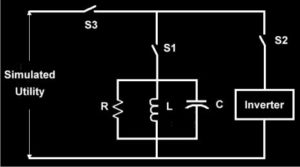UL 16741 the standard for anti-islanding protection
In the event of a power failure on the electric grid, it is required that any independent power-producing inverters attached to the grid turn off in a short period of time. This prevents the DC-to-AC inverters from continuing to feed power into small sections of the grid, known as “islands.” Powered islands present a risk to workers who may expect the area to be unpowered, and they may also damage grid-tied equipment.
A single inverter operating independently can easily detect the presence or lack of a grid source. However, if there are two inverters in a given island, things become considerably more complex. It is possible that the signal from one can be interpreted as a grid feed from the other, and vice versa, so both units continue operation.
Since 1999, the standard for anti-islanding protection in the United States has been UL 1741, harmonized with IEEE 1547.
Test Requirements/Procedures
The requirement for a unit under test is to detect an island condition and cease to energize the area electric power  system (EPS) within two seconds of the formation of an island. This disconnection time is measured from the point that the switch is opened up disconnecting the grid but leaving the islanding circuit connected and the point that the unit ceases exportation of current to the grid.
system (EPS) within two seconds of the formation of an island. This disconnection time is measured from the point that the switch is opened up disconnecting the grid but leaving the islanding circuit connected and the point that the unit ceases exportation of current to the grid.
The island load is adjusted to ensure a power quality factor (Q) of 1.0 (+/- 0.05) and the “central” balanced load condition. In addition, the output current flowing to the grid through the switch (S3) is limited to a maximum value of 2% of the rated output current and the Q=1.0 balanced load condition of the unit under test.
In addition to testing at the balanced load condition of Q=1.0, The test is to be repeated with the reactive load (either capacitive or inductive) adjusted in 1% increments from 95% to 105% of the initial balanced load component value. If the unit’s shutdown times are still increasing at the 95% or 105% points, additional 1% increments shall be taken until trip times begin decreasing.
The anti-islanding test is repeated for 3 output power levels: 33%, 66%, and 100% of the rated output power of the unit under test.
Pass Criteria
The test is considered complete when one of two situations occur:
- When disconnect times illustrate a pattern of decreasing times with respect to a balanced load condition yielding the longest disconnect time
- When the resultant tank circuit frequency is such that it is past the frequency trip point of the unit under test such that the unit under test is tripping offline due to a frequency fault
UL 1741 has other performance requirements as well, including power quality, interconnect integrity, and operating voltage and frequency parameters. For information about testing inverters to any of these requirements, contact us.
MET Labs is a leader in renewable energy product testing. Visit our Quote Center for a rapid response quote.




I understand the requirement to cease energizing within 2 seconds. How long does the inverter have to be de-energized before coming up to provide power to a local load w/ the utility breaker open?
Thanks
The standard does not directly address it, but from a lab perspective, common practice is to have the inverter wait a minimum of 5 minutes after the Area EPS steady-state voltage and frequency have been restored.
These requirements are for grid tied inverters, so if the utility breaker is open then the inverter will remain idle until, as admin said, voltage and frequency have been restored.
In some european countries you must wait 3 minutes, but in others there is no requirement about that.
The equivalent standard in Australia, AS 4777.3, requires that AC power be within voltage and frequency limits for one minute before reconnecting the generator.
The disconnect requirement is the same, 2 seconds.